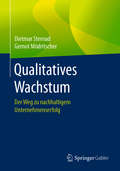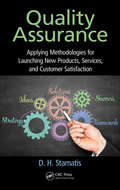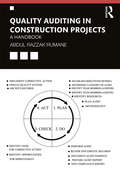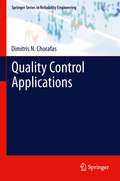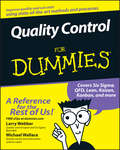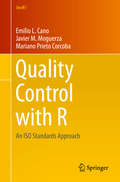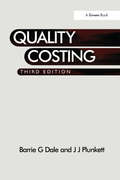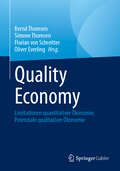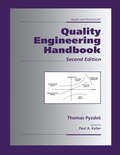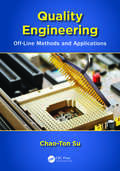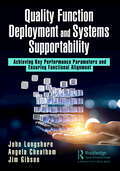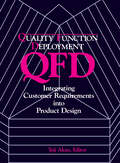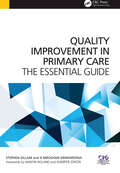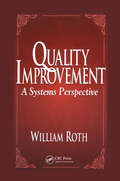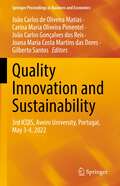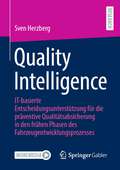- Table View
- List View
Qualitative Theory of Dynamical Systems, Tools and Applications for Economic Modelling
by Gian Italo Bischi Anastasiia Panchuk Davide RadiThe book presents the lectures delivered during a short course held at Urbino University in summer 2015 on qualitative theory of dynamical systems, included in the activities of the COST Action IS1104 "The EU in the new economic complex geography: models, tools and policy evaluation". It provides a basic introduction to dynamical systems and optimal control both in continuous and discrete time, as well as some numerical methods and applications in economic modelling. Economic and social systems are intrinsically dynamic, characterized by interdependence, nonlinearity and complexity, and these features can only be approached using a qualitative analysis based on the study of invariant sets (equilibrium points, limit cycles and more complex attractors, together with the boundaries of their basins of attraction), which requires a trade-off between analytical, geometrical and numerical methods. Even though the early steps of the qualitative theory of dynamical systems have been in continuous time models, in economic and social modelling discrete time is often used to describe event-driven (often decision-driven) evolving systems. The book is written for Ph. D. and master's students, post-doctoral fellows, and researchers in economics or sociology, and it only assumes a basic knowledge of calculus. However it also suggests some more advanced topics.
Qualitative und quantitative Eigenkapitalanforderungen: Theoretische Beiträge zur aktuellen Bankenregulierung
by Stefan MayerNach der globalen Finanzkrise 2007/08 herrschte die Handlungsmaxime: Banken müssen mit mehr Eigenkapital ausgestattet sein und dieses Eigenkapital muss von besserer Qualität sein. Dass das Eigenkapital einer Bank sowohl einen quantitativen als auch qualitativen Aspekt haben kann, ist ein besonderes Phänomen der Bankenregulierung. Denn das Eigenkapital einer Bank ist nichts Physisches, sondern ein Residualbetrag. Das Eigenkapital einer Bank kann erst nach Verkauf aller Aktiva und Befriedigung aller Passiva mit Sicherheit bestimmt werden. In der Bankenregulierung existiert ein Vielfaches an Eigenkapitalanforderungen. Diese beziehen sich mehr auf den quantitativen oder auf den qualitativen Aspekt von Eigenkapital. Während regulatorische Anforderungen hinsichtlich des quantitativen Aspekts vielfach untersucht wurden, weist der Stand der Forschung auch mehr als eine Dekade nach der Finanzkrise keine systematische Untersuchung zur Regulierung der Qualität des Eigenkapitals von Banken auf. Diese Untersuchung schließt diese Lücke.
Qualitatives Wachstum: Der Weg zu nachhaltigem Unternehmenserfolg
by Dietmar Sternad Gernot MödritscherDieses Buch beinhaltet einen grundlegend neuen Denkansatz zum Unternehmenswachstum. Es beschreibt Grundprinzipien, Strategien, Methoden und Instrumente zur qualitativen Weiterentwicklung von Unternehmen. Weit über den üblichen Rahmen klassischer Qualitätsmanagementsysteme hinaus wird ein ganzheitlicher Ansatz vorgestellt, mit dem Unternehmen in einer Kombination aus deutlichen Qualitätssprüngen und einer systematischen Weiterentwicklung wettbewerbsfähigere Qualitäts- und Leistungsniveaus erreichen können. Fallstudien aus der Unternehmenspraxis verdeutlichen anschaulich, wie sich wesentliche Handlungsfelder für qualitatives Wachstum identifizieren sowie gezielte Entwicklungsmaßnahmen einleiten und umsetzen lassen, um gleichzeitig bessere Leistungsangebote, nachhaltigen wirtschaftlichen Erfolg und positive Auswirkungen auf Umwelt und Gesellschaft zu erreichen.
Qualities of an Adaptive Organization: How Does Your Organization Measure Up?
by Alexander Grashow Marty Linsky Ronald HeifetzDiagnosing the organizational system, the adaptive challenge at hand, and the political landscape in an enterprise takes time, careful thought, and courage. You have to improvise creatively and responsively as you engage stakeholders inside and across the boundaries of your organization. Some organizations have the keen external sensors, internal norms, and a critical mass of people to do this. What distinguishes these enterprises? What makes some organizations more adaptive than others? In this chapter, the authors identify the characteristics that make some organizations more adaptive than others and offer a worksheet that will help you assess how well your organization stacks up. This chapter was originally published as chapter 7 of "The Practice of Adaptive Leadership: Tools and Tactics for Changing Your Organization and the World."
Quality Assessment and Enhancement in Higher Education in Africa (Routledge Contemporary Africa)
by Peter Neema-AbookiThis book explores quality assessment and enhancement in higher education in Africa to illustrate the need to develop quality practices in measuring effective education and continually search for permanent improvement. The book demonstrates that technological and socio-economic trends, innovations, and inventions of the twenty-first century demand that additional attention be placed upon education for national, regional, and international development. Since conventions for quality assessment and enhancement need to be defined and systematic structures constructed to develop quality practices, the book shows how quality in higher education within Africa has been established and advanced to provide a framework for monitoring, auditing, and reviewing assessment and enhancement. Though the book considers African complexities and diversity, it incorporates global trends and utilises an international focus that enables readers to devise appropriate strategies for developing and enhancing quality and standards in higher education in both continental Africa and beyond. Illustrating why quality assessment and enhancement should be embraced in all aspects including inputs, processes, outputs and outcomes in educational settings globally, this book will be of interest to policymakers and scholars in the fields of Higher Education, Quality and Global Studies, African Education, African Studies and Management and Administration, Leadership and Professional Development Studies.
Quality Assurance and Certification in Ecotourism
by Rosemary Black Alice CrabtreeThis book explores solutions to the problems of inconsistency and even exploitation of the term ecotourism through examples, case studies and a discussion of quality control and certification.
Quality Assurance and the Law
by Richard Reeves Elaine PritchardOver the last 25 years there has been a considerable increase in the awareness of quality related issues. In the world of business and commerce, this awareness has manifested itself in the development of what was the British Quality Standard BS 5750 into what is now the international standard BS EN ISO 9000. Alongside all of this, consumers in general have developed increasingly demanding expectations with regard to the quality of goods and services available in the market place. During a similar period there has also been an increase in legislation, together with an expansion of the common law, which has strengthened the protection already afforded to the consumer. This book will provide quality practitioners, managers and those with a general interest in quality, with an insight into the legal issues involved. In addition, the book shows how the implementation of a Quality Assurance Management System - such as that required in order to be registered as a firm of assessed capability, in accordance with BS EN ISO 9000 - can act as an aid to businesses seeking to comply with their legal obligations.In addition, for those following a formal course of study, the contents will prove to be particularly useful to students undertaking the Institute of Quality Assurance's Associate Membership examination: Principles and Techniques of Quality Assurance.
Quality Assurance: Applying Methodologies for Launching New Products, Services, and Customer Satisfaction (Practical Quality Of The Future Ser.)
by D. H. StamatisAlthough regularly introducing new products or services is the lifeblood of most industries, bringing them to market can be fraught with peril. Timing, cost, and quality all play important roles in a successful product launch and avoiding expensive- often in more than just dollars- recalls and redesigns. Quality Assurance: Applying Methodologies fo
Quality Auditing in Construction Projects: A Handbook
by Abdul Razzak RumaneThis book provides construction professionals, designers, contractors and quality auditors involved in construction projects with the auditing skills and processes required to improve construction quality and make their projects more competitive and economical. The processes within the book focus on auditing compliance to ISO, corporate quality management systems, project specific quality management systems, contract management, regulatory authorities’ requirements, safety, and environmental considerations. The book is divided into seven chapters and each chapter is divided into numbered sections covering auditing-related topics that have importance or relevance for understanding quality auditing concepts for construction projects. No other book covers construction quality auditing in such detail and with this level of practical application. It is an essential guide for construction and quality professionals, but also for students and academics interested in learning about quality auditing in construction projects.
Quality Beyond Six Sigma: A Lean Approach To Building Sustainable Quality Beyond Six Sigma
by Ron Basu Nevan WrightSix Sigma is a data-driven management system with near-perfect performance that is a statistical target of operating with no more that 3.4 defects per one million chances. Six sigma has both created avid interest and raised concerns among executives and its practioners. This is all very well for multinationals like Motorola or General Electric but how can it help small and medium-sized enterprises or the service industry? How do you ensure that solutions stick? Quality Beyond Six Sigma responds to this challenge and provides a practical implementation of the issues of Six Sigma, Lean Enterprise and Total Quality and aligns the 'hard' sigma message with the softer sustainable 'strategic issues'. The result is FIT SIGMA.The authors utilize major and minor case studies to support principles and learnings of FIT SIGMA and include review examples and self-assessment that underpin the sustainable process. The three major case studies are contributed by General Electric, Dow Chemical and Seagate Technology.Senior Executives and Managers of organizations of all types and sizes, Management Consultants and Students of all disciplines will find this book a stimulating guide to quality and operational excellence.
Quality Control Applications
by Dimitris N. ChorafasQuality control is a constant priority in electrical, mechanical, aeronautical, and nuclear engineering - as well as in the vast domain of electronics, from home appliances to computers and telecommunications. Quality Control Applications provides guidance and valuable insight into quality control policies; their methods, their implementation, constant observation and associated technical audits. What has previously been a mostly mathematical topic is translated here for engineers concerned with the practical implementation of quality control. Once the fundamentals of quality control are established, Quality Control Applications goes on to develop this knowledge and explain how to apply it in the most effective way. Techniques are described and supported using relevant, real-life, case studies to provide detail and clarity for those without a mathematical background. Among the many practical examples, two case studies dramatize the importance of quality assurance: A shot-by-shot analysis of the errors made in the Fukushima Daiichi nuclear disaster; and the engineering failure with new technology due to the absence of quality control in an alternative energy project. This clear and comprehensive approach makes Quality Control Applications an essential reference for those studying engineering as well industry professionals involved in quality control across product and system design.
Quality Control for Dummies (For Dummies Ser.)
by Michael Wallace Larry WebberSo you’ve been asked to lead a quality control initiative? Or maybe you’ve been assigned to a quality team. Perhaps you’re a CEO whose main concern is to make your company faster, more efficient, and less expensive. Whatever your role is, quality control is a critical concept in every industry and profession. Quality Control For Dummies is the straightforward, easy guide to improving your company’s quality. It covers all of today’s available options and provides expert techniques for introducing quality methods to your company, collecting data, designing quality processes, and more. This hands-on guide gives you all the tools you’ll ever need to enhance your company’s quality, including: Understanding the importance of quality standards Putting fundamental quality control methods to use Listening to your customer about quality issues Whipping quality control into shape with Lean Working with value stream mapping Focusing on the 5S method Supplement a process with Kanban Fixing tough problems with Six Sigma Using QFD to win customers over Improving you company with TOC This invaluable reference is written from an unbiased viewpoint, giving you all the facts about each theory with no fuzzy coverings. It also includes steps for incorporating quality into a new product and Web sites packed with quality control tips and techniques. With Quality Control For Dummies, you’ll be able to speed up production, eliminate waste, and save money!
Quality Control with R
by Emilio L. Cano Javier M. Moguerza Mariano Prieto CorcobaPresenting a practitioner's guide to capabilities and best practices of quality control systems using the R programming language, this volume emphasizes accessibility and ease-of-use through detailed explanations of R code as well as standard statistical methodologies. In the interest of reaching the widest possible audience of quality-control professionals and statisticians, examples throughout are structured to simplify complex equations and data structures, and to demonstrate their applications to quality control processes, such as ISO standards. The volume balances its treatment of key aspects of quality control, statistics, and programming in R, making the text accessible to beginners and expert quality control professionals alike. Several appendices serve as useful references for ISO standards and common tasks performed while applying quality control with R.
Quality Costing
by Barrie G. Dale J.J. PlunkettQuality costs help to show the importance of quality-related activities to management; they demonstrate the cost of non-quality to an organization; they track the causes and effects of the problem, enabling the working out of solutions using quality improvement teams, and then monitoring progress. As a technique in the introduction and development of TQM, quality costing is a powerful tool for enhancing a company’s effectiveness. Quality Costing provides pragmatic advice on how to set about introducing and developing a quality costing system and using the data that emerges. This third edition (strengthened by additional data from a range of organizations) provides sound practical guidance on how to define, identify, collect, measure, analyse, report and use quality costs. This established text has proved invaluable to managers and quality professionals, students and academics alike - the new edition ensures its continued position as the leading book in the field.
Quality Economy: Limitationen quantitativer Ökonomie, Potenziale qualitativer Ökonomie
by Oliver Everling Bernd Thomsen Simone Thomsen Florian Von SchreitterDieses Buch informiert über drängende globale Herausforderungen, diskutiert Lösungsansätze, schafft ein besseres Verständnis für die Neudefinition von Wohlstand und dessen gerechte Verteilung und zeigt die Rolle und die Chancen einer qualitativen Wirtschaft auf. Es trägt dazu bei, die komplexen Themen, beispielsweise in den Bereichen Ressourcenmanagement, Technologie und sozioökonomische Systeme, zu beleuchten und Wege zur Bewältigung der Probleme aufzuzeigen. Es gibt Grund zum Optimismus, denn wir Menschen haben die Zukunft in der Hand! In gleichem Maße, wie wir die spanische Grippe, die Pest und Covid-19 in den Griff bekamen, werden wir auch nötige Veränderungen in der Wirtschaft so erfolgreich gestalten, dass wir die Herausforderungen meistern, die unser Planet und das Zusammenleben von uns Menschen erfordert. Ebenso klar ist den renommierten Autoren dieses Buches, dass eine Ökonomie, die nur quantitativen Zielsetzungen unterliegt, weder die aktuelle Lebenswirklichkeit noch künftige gesellschaftliche Anforderungen abzubilden vermag und damit nicht zukunftsfähig ist. “Wir brauchen eine Qualitative Ökonomie” - das ist die zentrale Botschaft dieses Buches. Wie diese genau aussieht, wie sie klassisches volks- und betriebswirtschaftliches Vorgehen ergänzt, welche Themenfelder dabei wichtig sind und künftig werden und warum das nicht nur zu qualitativ, sondern auch quantitativ besseren Resultaten führt, zeigt dieses Buch eindrucksvoll.
Quality Education and International Partnership for Textile and Fashion: Hidden Potentials of East Africa (SDGs and Textiles)
by Hafeezullah Memon Xinfeng Yan Lihong ChenThis book mainly focuses on SDG4- Quality Education, and aims to understand the past, present, and future of textile, fashion, apparel, and related study majors of East African countries. Professors and field experts in textile engineering of selected countries describe the potential and prospects of textile education and how it can lead to internationalization in the various chapters. It also discusses the textile university alliance and the potential for international education related to textiles in the developing region. With updated illustrations, images, data, graphs and tables, this book serves as a reference book for universities with textile engineering major in countries throughout the world.
Quality Engineering Handbook (Quality and Reliability)
by Thomas Pyzdek Paul A. KellerWritten by one of the foremost authorities on the subject, the Second Edition is completely revised to reflect the latest changes to the ASQ Body of Knowledge for the Certified Quality Engineer (CQE). This handbook covers every essential topic required by the quality engineer for day-to-day practices in planning, testing, finance, and management an
Quality Engineering: Off-Line Methods and Applications
by Chao-Ton SuAs quality becomes an increasingly essential factor for achieving business success, building quality improvement into all stages-product planning, product design, and process design-instead of just manufacturing has also become essential. Quality Engineering: Off-Line Methods and Applications explores how to use quality engineering methods and othe
Quality Function Deployment and Systems Supportability: Achieving Key Performance Parameters and Ensuring Functional Alignment
by John Longshore Angela Cheatham Jim GibsonThis book not only presents the overall development of quality function deployment (QFD) and what it has been used for to date but a new product support orientation by which it can be employed. It is product and service “system” focused and presents how blending the processes and elements of supportability and analysis into a QFD-modeled methodology can achieve optimal cost savings and performance efficiency and effectiveness. In addition, a working model is provided that will assist those that elect to use such an approach to current/new product and/or service development. QFD is widely spreading throughout the world because of its outstanding usefulness. It is aimed to fulfill the customer’s expectation of a product or service design. Organizations of all sizes are using it to (1) save product and service design and development time, (2) focus on how the product or service might satisfy the customer and (3) improve communication at all levels of an organization during the development process. Based on these three reasons, today's traditional QFD can be divided into three branches and analyzed. First, QFD can be implemented effectively for developing new products and designs by establishing the linkage between design stages through the manufacturing environment. However, research has found that traditional QFD is quite weak in implementing modifications to existing product and service design during its predicted lifecycle. Second, most research to this point has been squarely focused on the “voice of the customer” for prioritizing customer needs. While certainly needed, the “voice of the system” that is being used to produce the product/service and how they operate during its intended life cycle has been given less attention. Third, QFD is often viewed as overly labor-intensive and thus costly, and, because of its team-based development logic, manual in nature by those involved during its development and implementation. Research has shown that life cycle sustainment planning and support for current or proposed products and/or services requires a seamless and balanced life cycle support methodology. To achieve this type of support, twelve functional elements have been identified that form the product support infrastructure. A new approach, one that views product support as an integrative activity where all twelve product support elements are assessed over the entire product and/or service life cycle is being deployed. With this deployment comes a need to ensure Key Performance Parameters (KPPs) are achieved and functional alignment obtained by balancing supportability element cost and provisioning throughout the entire product and/or service lifecycle, not just during the development stage, and to view the system as the “customer” and thus listen to the “Voice of the System” when assessing supportability requirements. Quality Function Deployment (QFD) is such a tool. This book contains four sections. Section 1 provides an initial overview of QFD origins, and history and highlights some of its use today. It addresses how QFD fits within the organization, increasing revenue, and reducing cost. It outlines a step-by-step strategy for successfully deploying QFD within the organization. Section 2 examines the evolving product and/or service requirement, creating the design solution using QFD, assessing supportability characteristics using QFD, and performing functional supportability analysis using QFD. Section 3 provides a guide for developing the life cycle supportability solution using QFD methodology on an ongoing basis, and managing processes throughout the systems lifecycle. Section 4 addresses using QFD in an imperfect world and will provide insight into how to use QFD beyond the standard “house of quality” concept.
Quality Function Deployment: Integrating Customer Requirements into Product Design
by Yoji AkaoQuality Function Deployment (QFD) is a method for satisfying customers by translating their demands into design targets and quality assurance points. For a thorough "how-to" on the implementation of QFD, we went directly to the source -- Yoji Akao, the creator of QFD and one of the foremost leaders of the Japanese Total Quality Control movement.In this unprecedented book he explains the concepts and methods of this remarkable systems engineering approach. Filled with case studies, detailed charts, and over 100 diagrams, this book is a complete reference tool for QFD implementation. It includes— Use of the demanded quality deployment chart.Using and promoting quality charts.Using quality control process charts: QFD at the pre-production.Quality deployment and reliability deployment.Quality development in the construction industry.QFD for the service industry.QFD for software development.
Quality Improvement Customers Didn't Want (HBR Case Study and Commentary)
by Mary Jo Bitner Thomas O. Jones Teresa A. Swartz Eric Hanselman Christopher A. Swan Mary Jane Bitner Dawn Iacobucci Terri CapatostoIs investing in new technology always the right choice for a company and its customers? Allan Moulter, the CEO of Quality Care, isn't sure he wants to invest in the computerized reception system that consultant Jack Zadow has outlined for him. But in this HBR case study, the argument Zadow makes is impossible to ignore. Quality Care's rivals have invested in similar systems or are planning to do so. The new system promises to take care of routine busywork, freeing staff up for other interactions with patients. It seems as if the competition hasn't even cut staff and is counting on increased customer retention to pay for the investment. And yet, Quality Care's surveys of its own customers show that they prefer the human touch when checking in. How would customers feel if the first "person" they met when they came in the door turned out to be a machine? Six experts weigh the costs and benefits of technology in a service industry. In 96106 and 96106Z, commentators Thomas O. Jones, Mary Jo Bitner, Eric Hanselman, Christopher A. Swan, Teresa A. Swartz, and Terri Capatosto offer advice on this fictional case study.
Quality Improvement in Primary Care: The Essential Guide
by Stephen GillamThis book provides readers with an invaluable set of tools to convert the endless challenges for quality and myriad opportunities for improvement into meaningful and useful change. It considers how to manage primary care organisations in order to improve quality of care; how general practices are regulated and held accountable; various techniques used for assessing and measuring; and commonly used quality improvement frameworks.
Quality Improvement: A Systems Perspective
by William RothQuality improvement: it's an attractive concept on paper. So why do the vast majority of quality improvement efforts fail?William Roth knows from experience: as a Ph.D in systems theory, an ex-corporate manager, a professor-and the designer (with the AQP) of a national program to deliver training for quality credentials in the systems approach. His belief: enduring quality improvement is an "all or nothing" situation-requiring a systemic approach, with all the key components and integrations in place and fully integrated right from the start. Quality Improvement: A Systems Perspective explains the sometimes surprising historic roots of the quality improvement movement, and outlines the systems theory on which successful models must be built. Readers then gain access to the hands-on, nuts-and-bolts, how-to-get-it-done details of the five critical phases. Three case studies (two in industry, one in health care) support this traditional but currently shunned model.Along with his unique unified view of quality improvement, Roth explains why it is shunned, and why alternative approaches usually do not produce the desired results. Key obstacles to success are directly identified-top-level management, local union leaders, management education. The ultimate culprit, though, is culture-to which Roth suggests how to move organizations in the right direction, from a systems perspective.With one of the most comprehensive overviews of quality management essentials in one volume, Quality Improvement: A Systems Perspective balances theory and modeling with the details of real-life implementation and success.
Quality Innovation and Sustainability: 3rd ICQIS, Aveiro University, Portugal, May 3-4, 2022 (Springer Proceedings in Business and Economics)
by Gilberto Santos João Carlos Gonçalves dos Reis Joana Maria Costa Martins das Dores João Carlos de Oliveira Matias Carina Maria Oliveira PimentelThis book provides various approaches to complex industrial problems in sustainability, operations management and industrial engineering. It features in-depth research presented by academics, scholars, researcher and professionals at the 3rd International Conference on Quality Innovation and Sustainability (ICQIS) in the fields of quality, innovation, sustainability and operations management. It addresses topics such as quality management systems; Lean and Six Sigma; information systems for quality management; data management and industry 4.0; innovative solutions for quality challenges; environmental quality policies and standards; circular economy and life cycle costing; occupational health; safety and welfare in manufacturing; and smart systems, among others.
Quality Intelligence: IT-basierte Entscheidungsunterstützung für die präventive Qualitätsabsicherung in den frühen Phasen des Fahrzeugentwicklungsprozesses
by Sven HerzbergAufgrund der hohen Dynamik und Komplexität im Kontext der Fahrzeugentstehung stellt die Produktqualität eine wesentliche Herausforderung für die langfristige Wettbewerbsfähigkeit von Automobilherstellern dar. Die Produktqualität wird dabei insbesondere durch Entscheidungen beeinflusst, die bereits in den frühen Phasen der Automobilentwicklung getroffen werden. Untersuchungen zeigen, dass die Verfügbarkeit relevanter qualitätsbezogener Informationen vor diesem Hintergrund einen erheblichen Beitrag zur Entscheidungsfindung leisten kann. Das Ziel der Forschungsarbeit liegt daher in der Erarbeitung eines IT-basierten Ansatzes zur Entscheidungsunterstützung zugunsten der präventiven Absicherung von Produktkonzepten in den frühen Phasen des automobilen Produktentwicklungsprozesses. Der Lösungsweg der vorliegenden Arbeit umfasst hierzu eine Exploration der präventiven Absicherung von Produktkonzepten in den frühen Fahrzeugentwicklungsphasen. Aufbauend auf den Erkenntnissen der Untersuchung wird als Hauptbestandteil der Arbeit ein fachliches Konzept zur Entscheidungsunterstützung entwickelt. Die konzeptionellen Schwerpunktbereiche werden anschließend unter Verwendung von Realdaten prototypisch implementiert und im Rahmen mehrerer Workshops mit Fachanwendern evaluiert.


